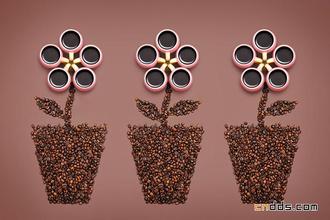Citrus-flavored Yega Shifeiwaka Coffee Flavor description Taste Variety treatment production area
Ethiopia's Yirgacheffe coffee is petite, but gentle and sweet. As the home of coffee, Ethiopia's millennia of growing and processing traditions have resulted in high-quality washed Arabica beans. Light baked with unique lemon, floral and honey sweet aromas, soft fruit acids and citrus notes, fresh and bright taste. No milk, no sugar, let the rich texture and unique soft floral brush your taste buds, leaving endless aftertaste…
Yegashefi is a small town, 700- 21,000 meters above sea level, synonymous with Ethiopian fine coffee. It is a wetland since ancient times, and the old saying "Yirga" means "settle down" and "Cheffe" means "wetland". The way coffee is produced and the flavor is so prominent that Ethiopian coffee farmers compete to be proud of their coffee with the flavor of Yegashefi, which has become Africa's most famous coffee producing area. Yegashefi coffee trees were planted by European monks and later by farmers or cooperatives. Yegashefi is actually formed by surrounding coffee communities or cooperatives, which generally include: Hafusa, Hama, and Biloa.
These mountain villages are foggy, spring all year round, cool but not hot in summer, rain but not damp in winter, and they breed unique regional flavors of citrus and flowers. Coffee trees are grown mostly in farmers 'backyards or mixed with other crops in the field. Yerga sherfi refers to yerga sherfi grown in ethiopia. Yega Shefi is the name of a local town. The altitude ranges from 1700 to 2100 meters. Yerga Shefi is now synonymous with Ethiopian specialty coffee.
Ethiopian coffee is graded not according to the number of seeds, but according to the proportion of defective beans in the raw beans. In October 2009, Ethiopia launched the ECX Fine Coffee Trading Grading System. Q-Grader rated green beans as follows:
There are two grades of Grade 1 and Grade 2.
Sunlight plus snow is divided into Grade 1, Grade 3, Grade 4 and Grade 5.
Grade 1 is the highest grade, i.e. the lowest defect rate and the best quality. The washed Yegashefi has unique lemon flavor, refreshing jasmine flower fragrance, soft fruit acid and citrus flavor, fresh and bright taste.
Sunlight yejia sherry has charming fruit acid, clean fermented fruit sweet, elegant fruit fragrance, sweet aftertaste Ethiopia's traditional sun-treatment method is relatively rough, heavy miscellaneous taste, criticized by people. In 1959, Yejia Shefei production area introduced South American washing treatment method, most production areas are generally used washing treatment, that is, coffee fruit peeling, fermentation, washing process after removing pectin layer, and then drying.
Since 2006, some coffee processing plants in some producing areas have adopted exquisite overhead solarization, which involves intensive manual labor to isolate the coffee fruit from contact with the ground and prevent the dirt from being produced in the process of solarization, creating an unusually clean fruit flavor. After more than two weeks of sun exposure, the dark brown coffee cherries are professionally stored, waiting for the full flavor to ripen. Before sale, the dried cherry pulp and sheepskin are removed, and then the immature beans and overfermented beans are eliminated. Strict control greatly improves the quality of the sun-dried beans.

Important Notice :
前街咖啡 FrontStreet Coffee has moved to new addredd:
FrontStreet Coffee Address: 315,Donghua East Road,GuangZhou
Tel:020 38364473
- Prev

Description of Bolivian Coffee Flavor of refreshing Perfume
The following are the basic information and cup test taste of this batch of champion beans: the following materials are the Osher Cup test report and the official website of CoE: country: Bolivia, Bolivia producing area: Yungas of La Paz Administrative Town: Yanacahi Award winning Manor: Agrotakesi SA Manor owner: Mauricio Ramiro Diez de Medina Rank: No.1 (2009 CoE Champion)
- Next

Description of Kenyan Jinchu Coffee Flavor with acidity of Fruit
Kenyan coffee is mostly grown at an altitude of 1500m, 2100m, and is harvested twice a year. To ensure that only ripe berries are picked, people must tour the forest about seven times. Kenyan coffee is grown by small farmers. After they harvest the coffee, they first send the fresh coffee beans to the cooperative cleaning station, where the washed and dried coffee is covered with parchment beans.
Related
- Detailed explanation of Jadeite planting Land in Panamanian Jadeite Manor introduction to the grading system of Jadeite competitive bidding, Red bid, Green bid and Rose Summer
- Story of Coffee planting in Brenka region of Costa Rica Stonehenge Manor anaerobic heavy honey treatment of flavor mouth
- What's on the barrel of Blue Mountain Coffee beans?
- Can American coffee also pull flowers? How to use hot American style to pull out a good-looking pattern?
- Can you make a cold extract with coffee beans? What is the right proportion for cold-extracted coffee formula?
- Indonesian PWN Gold Mandrine Coffee Origin Features Flavor How to Chong? Mandolin coffee is American.
- A brief introduction to the flavor characteristics of Brazilian yellow bourbon coffee beans
- What is the effect of different water quality on the flavor of cold-extracted coffee? What kind of water is best for brewing coffee?
- Why do you think of Rose Summer whenever you mention Panamanian coffee?
- Introduction to the characteristics of authentic blue mountain coffee bean producing areas? What is the CIB Coffee Authority in Jamaica?

